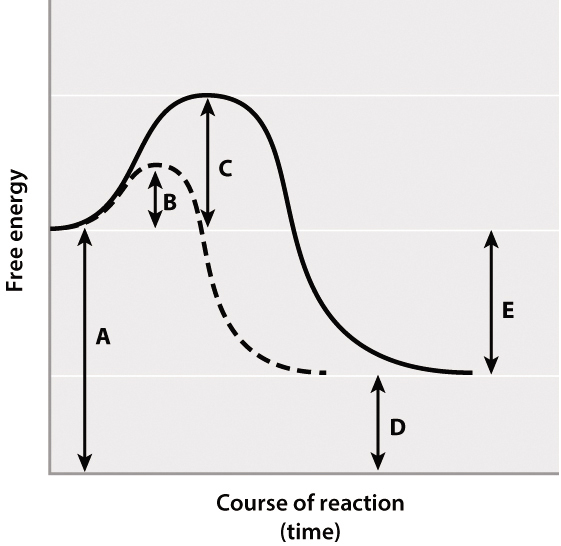Rethinking Assessment
Well-
Alignment
If the questions, exercises, and activities in the course aren’t aligned with course objectives and materials, practice with these resources may not help students succeed in their exam or in future biology courses. Each How Life Works assessment item is carefully aligned to the goals and content of the text, and to the assessment items used in other parts of the course. Students are guided through a learning path that provides them with repeated and increasingly challenging practice with the important concepts illustrated in the text and media.
Flexibility
The How Life Works assessment authors teach in a variety of classroom sizes and styles, and recognize that there is a wide diversity of course goals and circumstances. Each set of materials, from in-

Answer the following questions about the reactions shown in the graph.
Which arrow indicates the activation energy of the catalyzed reaction?
 A |
A |  B |
B |  C |
C |  D|
D|  E
E
Which arrow indicates the activation energy of the uncatalyzed reaction?
 A |
A |  B |
B |  C |
C |  D |
D |  E
E
Which arrow represents the free energy of the substrate?
 A |
A |  B |
B |  C |
C |  D |
D |  E
E
Which arrow indicates the free energy of the products?
 A |
A |  B |
B |  C |
C |  D |
D |  E
E
Which arrow indicates the change in free energy (?G) of the reaction?
 A |
A |  B |
B |  C |
C |  D |
D |  E
E
Is the reaction illustrated by the solid line endergonic or exergonic?
a.) endergonic b.) exergonic
Is the reaction illustrated by the dashed line endergonic or exergonic?
a.) endergonic b.) exergonic
Which of the following reactions would you predict could be coupled to ATP synthesis from ADP + Pi? Select all that apply.
a.) creatine phosphate + H2O → creatine + Pi, ΔG -10.3 kcal/mol
b.) phosphoenolpyruvate + H2O → pyruvate + Pi, ΔG -14.8 kcal/mol
c.) glucose 6-
d.) glucose 1-
e.) glutamic acid + NH3 → glutamine, ΔG +3.4 kcal/mol
The emperor penguins of Antarctica live on a diet of fish and crustaceans obtained from the cold Antarctic seawaters. During their annual breeding cycle, however, they migrate across the frozen continent to their breeding grounds 50 miles away from the sea (and 50 miles away from their source of food). For over two months the male emperor penguins care for and incubate the eggs while the females return to the sea to feed. During this time a male penguin can lose up to 50% of its biomass (by dry weight). Where did this biomass go?
a.) It was converted to CO2 and H2O and then released.
b.) It was converted to heat and then released.
c.) It was converted to ATP molecules.